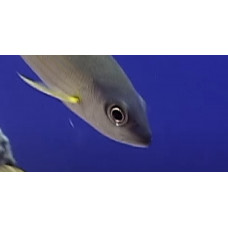Eyes are the visual organs of fish that enable them to perceive light stimuli. Demersal fish have eyes in the upper part of the head (monkfish, stingrays, flatfish), while pelagic fish have eyes on the sides of the body at the level of the longitudinal axis of the body (spruce, roach, omul, etc.). The size of the eyes depends on the lighting. With increasing depth and decreasing light intensity, the size of the eyes increases. Deep-sea fish have telescopic eyes. Among jawless fishes, the lamprey has well-developed eyes, while the carp has only primitive eye spots. The ancestors of modern hagfish, thought to be protopods, were apparently driven into very deep, dark waters where they were less vulnerable to sighted predators and where it is advantageous to have a convex eye spot that collects more light than a flat or concave one. Fish vision shows evolutionary adaptation to their visual environment, for example deep-sea fish have eyes adapted to darkness.
Fish eyes are generally similar to those of other vertebrates, especially tetrapods (amphibians, reptiles, birds and mammals, all descended from the fish ancestor). Light enters the eye through the cornea, passes through the pupil and reaches the lens.
Most fish species appear to have a fixed pupil size, but elasmobranchs (such as sharks and rays) have a muscular iris that allows the pupil diameter to be adjusted. The shape of the pupil varies and can be round or slit-shaped. The crystals are usually spherical, but in some species they may be slightly elliptical.
Compared to terrestrial vertebrates, the lens of fish tends to be denser and more spherical. In the aquatic environment, there is no significant difference in the refractive index of the cornea and the surrounding water (compared to air on land), so the lens has to provide most of the refraction. Due to the 'refractive index gradient within the lens - as expected from optical theory', spherical fish lenses are able to produce clear images free from spherical aberration. After passing through the lens, light is transmitted through a transparent fluid medium until it reaches the retina, which contains photoreceptors.
As in other vertebrates, the photoreceptors are located in the inner layer, so light must pass through layers of other nerve cells before it reaches them. The retina contains rods and cones. There are similarities between the eyes of fish and other vertebrates. Normally, light passes through the cornea of the fish eye and through the pupil to reach the lens. Most fish species have a fixed pupil size, while a few species have a muscular iris that allows the pupil diameter to be adjusted.
Fish eyes have a more spherical lens shape than other land vertebrates. In mammals and birds, focusing is usually achieved by changing the shape of the crystalline lens, whereas in fish it is achieved by moving the lens away from or closer to the retina. Fish retinas usually have both cone and rod cells responsible for scotopic and photopic vision.
Most fish have colour vision. Some species can see ultraviolet light, while others are sensitive to polarised light. Fish retinas have bacillus cells, which provide high visual sensitivity in low light conditions, and cone cells, which provide higher temporal and spatial resolution than the bacillus cells. They provide colour vision by comparing the absorption capacity of different types of cones.
Accommodation is the process by which the vertebrate eye adjusts the focus on an object as it moves closer or further away. While birds and mammals achieve accommodation by deforming the lens of their eye, fish and amphibians typically adjust focus by moving the lens closer or further away from the retina. They use a special muscle that changes the distance of the lens from the retina. In bony fish, this muscle is called the lenticular retractor and is relaxed for near vision, whereas in cartilaginous fish it is called the lenticular transporter and is relaxed for distance vision. Thus, bony fish adapt to distance vision by moving the lens closer to the retina, whereas cartilaginous fish adapt to near vision by moving the lens further away from the retina.
Eyes
Tags: eyes




